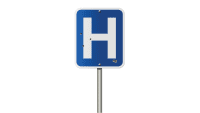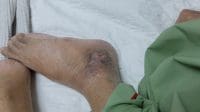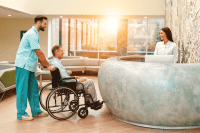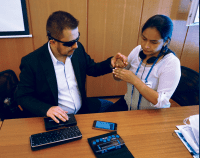Keeping hospital patients safe from untoward events is a crucial aspect of the essence of nursing. Every healthcare organization is accountable for the care and safety of its patients. Patient falls and pressure ulcers are costly—in time, money, and lives. (See The high toll of falls and pressure ulcers.) What’s more, falls and pressure ulcers are “never events”—healthcare errors that should never occur, as defined by the National Quality Forum. Considered preventable and serious, “never events” reflect a problem in the healthcare delivery system. In this article, we present a case study to illustrate how to help prevent falls and pressure ulcers.
Anna Roberts, age 75, is admitted to the orthopedic-surgical unit on your shift to recover from surgery for a fractured patella. After misjudging a small step when entering a store, she fell and injured her left knee and was taken to the hospital by ambulance.
Mrs. Roberts arrives on your unit with a dressing, a long soft splint, and I.V. access for pain-control medication. When you assess her, you find her alert and oriented to time, person, and place. She states she is a widow and has been living independently at home. She is able to drive and keeps busy with various hobbies. Her daughter lives nearby and visits often. She tells you she has been planning a trip to Europe with friends next year. Now she worries her knee injury could prevent her from going.
You know that for Mrs. Roberts and other elderly patients, a fall may lead to a functional decline. You also know she has multiple risk factors for falls and skin breakdown. Naturally, you want to help her avoid another fall and prevent skin breakdown. Risk factors for falls include advanced age, certain medications, and inactivity due to medical conditions that cause weakness or dizziness. Because of her injury, Mrs. Roberts is at increased risk for falls due to the new pain medications she’s taking, clumsiness caused by her leg splint, the need for crutches, and her decreased activity level. Splint use and decreased mobility also raise her risk for pressure ulcers.
To promote her recovery in the hospital and plan her return to previous activities, you set the following care goals: preventing falls, keeping her active while controlling her pain, promoting skin integrity, and helping her feel comfortable about going home without fearing she’ll fall again.
Assessing your patient’s fall risk
Multiple tools are available to help clinicians assess patients for fall risk:
- The Timed Up and Go test is a short, simple, and reliable screening test for balance problems. The evaluator times the patient as she rises from a chair, walks 3 meters, turns, and walks back to the chair. Performance is graded on a scale of 1 to 5, with 1 indicating normal and 5 denoting severely abnormal. A score of 3 or higher indicates an increased fall risk.
- The Balance Evaluation Systems Test differentiates among balance deficits. It consists of 36 items in six underlying systems that affect balance, helping clinicians focus on treatments for specific balance problems. It takes 30 minutes to complete.
- The Tinetti Scale evaluates balance and gait to determine the patient’s risk for falling in the home. Assessing both gait and balance, it’s useful for patients with a history of or high risk for falls. A healthcare provider or family member may administer the Tinetti Scale.
Preventing falls
Universal fall precautions, which apply to all patients regardless of fall risk, revolve around keeping the patient’s environment safe and comfortable. They focus on keeping all patients SAFE: Safe environment, Assist with mobility, Fall risk reduction, Engage the patient and family. (You can read more about risk assessment elsewhere in this supplement.)
In the hospital, engagement includes promoting communication among employees, family members, and friends regarding the patient’s need for help getting to the bathroom, nonskid socks, and use of a walker or bed alarm when no one is with him or her. A bed alarm signals the healthcare team that the patient is getting out of bed. Special floor mats that protect patients if they fall out of bed also may be appropriate. These measures can be especially helpful with confused patients.
In some facilities, at-risk patients wear colored armbands to alert others of their fall potential. This helps caregivers determine how much assistance the patient needs during transport and whether to house him or her in a room near the nurses’ station. Some facilities assign different levels of fall risk, indicated by color-coded armbands or markers on the outside of the patient’s door.
Keeping the bed rails down is important, too. When all rails are up, the patient is more likely to try to crawl over them to get out of bed, increasing the risk of falling. In rare cases, a confused patient must be restrained. However, restraints should be used only as a last resort because they can increase patients’ agitation and cause serious injury. Make sure you’re familiar with your facility’s restraint policies and procedures. If your patient is restrained, check the restraint throughout your shift for appropriate tightness and skin irritation. Ensure the patient has easy access to the call button.
Before discharge, evaluate the patient’s risk for falling in the home. (See Reducing risk factors for falls at home.)
Promoting skin integrity
Starting on admission, assess patients daily for potential skin breakdown. Unless existing breakdown is documented on admission, the insurer will assume skin breakdown occurred after admission and won’t reimburse the hospital for related medical costs.
Use the Braden Scale to evaluate the patient’s risk for pressure ulcers. This scale assesses skin breakdown risk using six criteria—sensory perception, moisture, activity, mobility, nutrition, and friction and shear. Scores range from no risk to very high risk. For more information on the Braden scale, see http://consultgerirn.org/uploads/File/trythis/try_this_5.pdf. You also can use the Norton scale to identify at-risk patients (see www.ahrq.gov/professionals/
systems/long-term-care/resources/ pressure-ulcers/pressureulcertoolkit/putool7b.html).
Evaluate the patient’s age, mobility, and type of illness or injury. Elderly patients are at high risk for skin breakdown—especially those with hip fractures and others who must endure long periods of immobility.
To help prevent pressure ulcers, use a special mattress and turn the patient at least every 2 hours; patients at high risk may need to be repositioned and turned more often. Caregivers’ failure to recognize the need for an appropriate bed or mattress for a high-risk patient can lead to skin breakdown. A patient who is expected to be on prolonged bedrest may need a special air mattress to help prevent skin breakdown.
Be sure to assess skin areas under clothing, dressings, splints (as with Mrs. Roberts in our case study), or other devices. Remember—skin can start to break down within hours of compression. (See Preventing, detecting, and managing pressure ulcers.)
Adequate skin care may necessitate readjusting a splint or using special padding, such as under the patient’s heels. Clean the skin regularly; as you do this, evaluate skin under the padding for signs of breakdown.
Communication counts
Be sure to convey the patient’s risk for skin breakdown to other healthcare team members, particularly during handoff to other clinicians—especially if the skin has already started to redden. Improving communication among healthcare professionals, as by using the TeamSTEPPS® and SBAR (Situation, Background, Assessment, and Recommendation) methods, can help patients stay safe.
Patient education
Patient education plays a key role in preventing pressure ulcers. From the time of patients’ admission, teach them about the risk of potential skin breakdown and how to prevent it at home after discharge.
Promoting adequate nutrition
Nutrition helps maintain skin integrity and healing. Energy requires protein; during hospitalization, patients with a poor appetite may replace protein foods with simple carbohydrates. Some patients may make meals out of “junk” food instead of healthy proteins; for instance, they may eat a breakfast bar thinking it’s full of protein when it’s actually full of sugar, empty calories, and little protein. Healthy adults should consume 0.8 g of protein/kg/day. Many hospitalized patients need more—as much as 1.5 g/kg/day.
Proper wound healing requires amino acids, such as arginine and glutamine (found in red meat, fish, nuts, and dairy products) and a good multivitamin supplement containing vitamins A, B complex, C, and E, as well as magnesium, manganese, selenium, and zinc. Although nutrition research in the area of pressure ulcer care is limited, we know vitamin D is crucial to skin proliferation and plays a potential role in ulcer prevention. To help ensure your patient is obtaining adequate hydration and nutrition, arrange for a dietary consult, and educate the patient and family about proper nutrition.
The nurse’s advocacy role
Falls and pressure ulcers in elderly patients are nothing new, but these “never events” are getting more attention. They also have potential legal ramifications: A pressure ulcer that develops during a patient’s hospital stay may be grounds for a professional liability lawsuit. Hospitals may suffer financially because their reimbursements may decrease if safety measures aren’t carried out properly.
Acting as a patient advocate from admission through discharge can help you keep your patients safe. Advocate for hospital policies that help ensure patients stay safe. For instance, policies for fall-risk assessment programs with comprehensive guidelines for reducing and preventing falls can be created and implemented through fall-prevention teams and quality-improvement or risk-management teams.
Of course, nurses alone aren’t responsible for patient safety. All hospital employees must make patient safety a goal, including housekeeping, food services staff, certified nurse aides, and administrators. We often criticize patients for being nonadherent when the real problem may be lack of available services or inability to access them. Such services include a home hazards assessment, implementation of a fall-proofing plan, an at-home exercise program, and installation of a fall-proof alert system. Preventing falls both in the hospital and at home and increasing your knowledge of pressure ulcer prevention and management can help you keep patients in good health.
Before Mrs. Roberts is discharged, family members assess her home for fall risks. They remove throw rugs, install safety bars in her bathroom and shower, and purchase an affordable fall-alert system. Nine months after her surgery and discharge, Mrs. Roberts is back to her normal routine and is planning her upcoming trip to Europe.
Selected references
Assessment Tools: Try This® tools. 2015. Hartford Institute for Geriatric Resources. www.hart
fordign.org/practice/try_this/
Ayello EA. Predicting pressure ulcer risk. Best Practices in Nursing Care to Older Adults. Hartford Institute for Geriatric Resources. Revised 2012 consultgerirn.org/uploads/File/trythis/try_this_5.pdf
Berlowitz D, VanDeusen Lukas C, Parker V, et al. Preventing Pressure Ulcers in Hospitals: A Toolkit for Improving Quality of Care. Agency for Healthcare Research and Quality. (n.d.).www.ahrq.gov/professionals/systems/long-term-care/resources/pressure-ulcers/pressureulcertoolkit/putoolkit.pdf
Costs of falls among older adults. Centers for Disease Control and Prevention. Page last reviewed and updated September 22, 2014. www.cdc.gov/HomeandRecreationalSafety/Falls/fallcost.html
Marco S. Wound and Pressure Ulcer Management. Johns Hopkins Medicine. (n.d.). www.hop
kinsmedicine.org/gec/series/wound_care.html
Kalava UR, Cha SS, Takahashi PY. Association between vitamin D and pressure ulcers in older ambulation adults: results of a matched case-control study. Clin Interv Aging. 2011;6:213-9.
Lundgren J. Preventing pressure ulcers starts on admission. Wound Care Advisor. 2013;2(5). woundcareadvisor.com/preventing-pressure-ulcers-starts-on-admission-vol2-vol5/
Mancini M, Horak FB. The relevance of clinical balance assessment tools to differentiate balance deficits. Eur J Phys Rehabil Med. 2010;46( 2): 239-48.
Serious Reportable Events in Healthcare – 2011 Update: A Consensus Report. National Quality Forum. 2011. www.doh.wa.gov/Portals/1/Documents/2900/NQF2011Update.pdf
The authors work at the School of Nursing at Texas Tech University Health Sciences Center in Lubbock. Amy Moore is an associate professor. Rebecca Geist is an instructor.


















